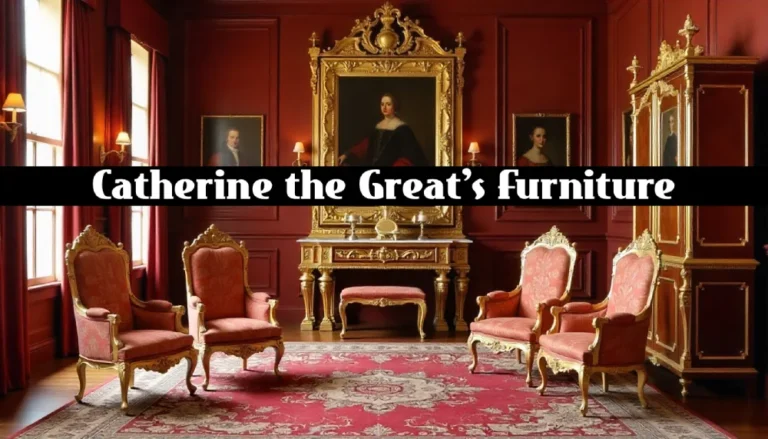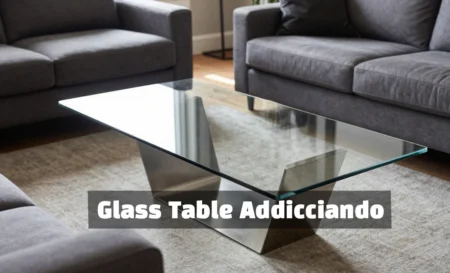When Catherine II of Russia commissioned a mahogany desk attributed to her court that later sold at auction for $1.3 million, she wasn’t just buying furniture. She was wielding cultural diplomacy through design. Catherine the Great’s furniture collection represents one of history’s most strategic uses of decorative arts to project imperial power and transform a nation’s cultural identity.
As the longest-reigning female ruler of Russia, she is celebrated for her dedication to Enlightenment ideals, her patronage of the arts and her progressive reforms. Her furniture choices became weapons in her mission to position Russia as Europe’s newest cultural superpower.
The Empress Who Revolutionized Russian Design
Catherine II ruled Russia from 1762 to 1796, transforming the empire during what became known as the Golden Age. Catherine II didn’t merely collect furniture; she weaponized it. Ascending the throne in 1762, she viewed interior design as a tool to modernize Russia and assert its sophistication.
Born Sophie of Anhalt-Zerbst, this German princess understood that legitimacy required more than political maneuvering. She needed to visually demonstrate that Russia was a sophisticated, enlightened, and formidable European power, not a remote backwater.
Her strategy was brilliant: commission the finest European craftsmen while developing Russian workshops to rival Parisian standards. She established imperial workshops, imported European masters (like David Roentgen), and mandated training in precision techniques.
Key strategic goals:
- Project Russia as culturally equal to France and England
- Support Enlightenment ideals through neoclassical aesthetics
- Create lasting artistic legacy
- Train Russian craftsmen to European standards
David Roentgen: Catherine’s Master Furniture Maker
The Roentgens’ ingenious inventions combined innovative designs with intriguing mechanical devices that revolutionized traditional types of European furniture. David Roentgen became Catherine’s most prized furniture supplier, creating pieces that amazed European courts.
He caught the fancy of the Empress herself with his Apollo Desk (1783-84), which depicted her favorite dog as a gilded mount, and which David produced on pure speculation. The empress became Roentgen’s most important client, paying for the Apollo desk the asking price of 20,000 rubles—a price comparable to that of a country estate—and adding as a token of appreciation a gold snuffbox and an additional 5,000 rubles.
Roentgen’s mechanical marvels included:
- Desks with secret compartments activated by hidden keys
- Automated drawers that emerged at the turn of a mechanism
- Clockwork tympanum (hammered dulcimer) player, dressed in up-to-the-minute fashions and bearing a strong resemblance to the queen herself
- Tables with concealed musical instruments
By 1789 Catherine and the Russian nobility had bought hundreds of pieces of Roentgen furniture, establishing “Neuwied Furniture” as a luxury brand throughout Russia.
Neoclassical Style Transforms Russian Palaces
Catherine abandoned the ornate Baroque style favored by previous Russian rulers. The Neoclassical style, sometimes called Louis Seize, or Louis XVI, began in the 1750s. Tiring of the Rococo style, craftsmen of the 18th century turned for inspiration to Classical art.
Her pieces whispered restraint: a writing desk with geometric marquetry parquets, or a chair with fluted legs mimicking Doric columns. Yet luxury prevailed—think amber inlays, ormolu mounts, and velvet upholstery dyed with rare cochineal.
Distinctive characteristics of Catherine’s neoclassical furniture:
- Straight lines and geometric forms replacing Rococo curves
- Use of columns, gilt, classical reliefs, moderate ornamentation, and satin upholstery
- Cuban mahogany (for its rich color), satinwood (for intricate marquetry), and Karelian birch (a speckled local wood used as veneer)
- Classical motifs: urns, lyres, laurel wreaths, acanthus leaves
- Mahogany-veneered furniture with ormolu mounts
Palace Showcases of Imperial Furniture
Catherine’s residences became living museums of her design philosophy. The Catherine Palace (Tsarskoye Selo): The Green Dining Room featured English-made mahogany tables with Russian-made gilded bronze mounts—symbolic of her hybrid approach.
The Winter Palace served as Catherine’s primary showcase. The Winter Palace, located in St. Petersburg, served as the official residence of the Russian monarchs. Under Catherine’s direction, it became a showcase of opulent interiors, filled with furniture that exemplified the finest craftsmanship of the time.
Pavlovsk Palace demonstrated Russian craftsmanship mastery. Designed by Charles Cameron, its Greek Hall housed chairs with klismos curves and settees draped in Lyon silk, proving Russian craftsmanship could equal French luxe.
The Hermitage Museum housed Catherine’s most precious pieces. Her private retreat displayed “mechanical tables” by Roentgen, featuring secret compartments and automatic drawers—marrying function with theatrical flair.
Russian Craftsmen Rise to European Standards
Catherine didn’t rely solely on foreign makers. She invited skilled craftsmen from France, Italy, and Germany to Russia to create pieces that combined European styles with Russian motifs. This cultural exchange resulted in a unique and eclectic mix of furniture styles in the imperial palaces.
Notable Russian furniture makers under Catherine:
- Gambs Brothers: Their St. Petersburg workshop produced iconic “Catherine” armchairs—mahogany frames with oval medallion backs
- Andrey Voronikhin: A serf-turned-architect whose marquetry work used 15 wood types to create trompe-l’oeil architectural vistas
- Matvey Veretennikov: Master of pietra dura, embedding jasper and lapis lazuli into tabletops
By incorporating elements of Rococo, Neoclassicism, and other European styles into her furniture, Catherine demonstrated her desire to align Russia with the cultural and artistic trends of the time.
Beyond Scandals: The Erotic Furniture Myth
The buzz around Catherine’s erotic art collection and furniture largely stems from reports by German soldiers during World War II. These troops supposedly — emphasis on supposedly — discovered a “sex room” filled with elephantine sexual equipment and pornographic glory.
The furniture was discovered by Wehrmacht soldiers in 1941, who were invading the palaces as part of Operation Barbarossa, an attempt by Hitler to overthrow the Soviet regime. They supposedly took these two photographs of the custom-made furniture before the palaces were bombed, and their contents destroyed in the ensuing fires.
No verified photographs of Catherine’s alleged erotic furniture have surfaced, and historians remain skeptical. Though these pieces lack definitive proof of association with the empress, their existence has inspired tantalizing speculation about Catherine’s private life.
The truth matters less than the myth’s impact on Catherine’s reputation, demonstrating how gender bias distorted historical narratives about powerful women.
Where to See Catherine’s Furniture Today
The vast majority of her collections, including her furniture, form the absolute core of one of the world’s greatest museums. Its collections, of which only a small part is on permanent display, comprise over three million items.
Major collections:
- The Hermitage Museum, St. Petersburg: The Hermitage was her personal museum. Wandering through the Neoclassical interiors of the Winter Palace, the Small Hermitage, and the Old Hermitage, you are quite literally walking through her home
- Catherine Palace, Tsarskoye Selo: Original furniture and accurate reproductions
- Pavlovsk Palace: Complete neoclassical furniture suites
- Metropolitan Museum of Art: Roentgen pieces and related collections
- Victoria & Albert Museum: Examples of 18th-century Russian furniture
Identifying Authentic Catherine-Era Furniture
Spotting genuine 18th-century Russian Neoclassical furniture involves detective work: Look for inventory stamps from palaces or makers like Roentgen (crown + “DR” monogram).
Authentication markers:
- Woods such as oak and walnut were commonly used in the furniture as well as mahogany veneer
- Ormolu (gilded bronze) mounts with specific maker marks
- High-quality materials, such as mahogany and gilded bronze
- Straight, clean lines and symmetrical shapes; geometric patterns like Greek keys; decorative motifs from antiquity
- Provenance documentation from imperial collections
Catherine’s Lasting Design Legacy
Catherine’s furniture legacy rippled far beyond palaces: Aristocratic Adoption: Russian nobles copied her styles, sparking demand for locally made “Neoclassical” suites. Cultural Shift: By prioritizing craftsmanship, she elevated furniture-making to a fine art, founding schools that trained generations.
Her patronage was the single most important force in Westernizing Russian taste in the decorative arts. Catherine’s furniture program succeeded in transforming Russia’s cultural reputation across Europe.
Modern designers still reference her approach: combining classical restraint with luxurious materials, emphasizing craftsmanship over decoration, and using furniture as cultural diplomacy.
Bottom line: Catherine the Great’s furniture collection was never just about decoration. It was a calculated cultural revolution that positioned Russia among Europe’s great powers, created a distinctly Russian neoclassical style, and demonstrated how design can serve diplomacy. Her legacy lives on in museums worldwide, proving that sometimes the most powerful political statements come carved in mahogany and gilded in gold.
Frequently Asked Questions
What style was Catherine the Great’s furniture?
Catherine embraced Neoclassical style, characterized by straight lines, geometric shapes, and classical motifs, moving away from ornate Baroque excess.
Who made Catherine the Great’s furniture?
David Roentgen was her most famous furniture maker, along with other European craftsmen and trained Russian workshops.
Where can you see Catherine the Great’s furniture today?
Most pieces are displayed at the Hermitage Museum in St. Petersburg, with additional collections at Catherine Palace and international museums.
How much is Catherine the Great’s furniture worth?
Authentic pieces sell for millions, with one desk attributed to her court selling for $1.3 million at auction.
What materials were used in Catherine’s furniture?
Cuban mahogany, Karelian birch, satinwood, ormolu mounts, and gilded bronze were commonly used materials.




